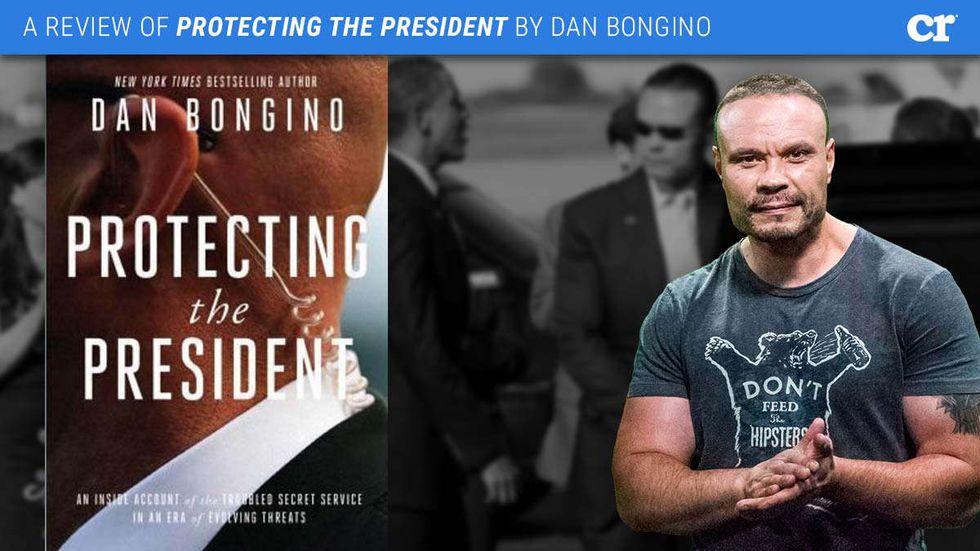
© 2024 Blaze Media LLC. All rights reserved.
Dan Bongino describes being a Secret Service agent as a “pressure cooker.”
“Every special agent, whether a supervisor or not, is expected to be able to handle, on a moment’s notice, an assignment where failure could mean the death of a world leader and a corresponding Archduke Ferdinand–like global crisis,” Bongino writes in his new book, “Protecting the President: An Inside Account of the Troubled Secret Service in an Era of Evolving Threats.”
The latest work from the New York Times best-selling author of “Life Inside the Bubble” and “The Fight” is a clarion call to the nation to confront the “existential crisis” of the Secret Service as an agency. This is serious business. And Bongino’s book identifies serious problems within the agency that jeopardize the work of the Secret Service, beleaguer its agents, and put the life of the president of the United States at risk.
In “Protecting the President,” Bongino brings decades of personal experience within the Secret Service to life for the reader. As he recounts in the book, Bongino began his career in law enforcement with the NYPD in 1995, joining the Secret Service in 1999 as a special agent assigned to investigate financial crimes. Bongino eventually worked his way into the prestigious Presidential Protection Division in 2006, protecting President George W. Bush, and remained on protective duty into President Barack Obama’s first administration before resigning in 2011 to run for elected office.
During his time with the Secret Service, Bongino witnessed firsthand how the bureaucratic tendencies of the federal government have infected the agency, impeding it from fulfilling its basic mission. The difference here is the mission is to protect the president of the United States — and failure will fundamentally and unpredictably transform the country.
There is not a single claim in this book that Bongino doesn’t back with stories from his time with the agency or meticulous research. In his telling, “sclerotic management, obsessed with the ‘old way’ of doing things,” a risk-averse resistance to change, and the ever-present bureaucratic problem of mission creep are forces acting to prevent the agency from adequately confronting evolving threats to the nation’s leadership in the modern world.
Bongino calls these evolving threats “The Bix Six.” They include tactical assaults on the president, chemical/biological weapons, explosives, airborne assaults, and fires. Bongino addresses each of these threats in separate chapters of his book, showing in clear detail where and how the Secret Service is prepared to deal with them and — more importantly — where it is not.
This is essential reading for policy makers who take seriously the responsibility of national security. Bongino’s threat assessments are applicable to many national security agencies, not the Secret Service alone.
“Protecting the President” is also delightful reading for law enforcement enthusiasts and anyone interested in how our national security agencies think and operate internally. There is an undeniable “cool factor” in learning how the Secret Service operates. The book is littered with Secret Service jargon, and Bongino helpfully defines acronyms like “NSSE” (National Special Security Events) and “OPFOR” (opposition force), teaching a language that previously was understood exclusively by some of the most elite law enforcement officers in the country.
Bongino’s writing is clear, precise, and detailed. This book is part history of the Secret Service, part policy paper, and part personal biography, tied together in a way that is easy to read and comprehend. The personal experience brought to every page of this book gives the reader a pressing sense of urgency to see the agency restored to its historic greatness.
“Protecting the President” will help you see the Secret Service in a new light. The chapters on the growing burden social media and President Trump’s Twitter use places on the work of the agency — and on the disturbing holes in the White House security plan — are particularly eye-opening.
But identifying problems is not enough for the author. “The real question we should ALL be asking is, ‘What the hell are we going to do about it?’” Bongino writes. In answer, Bongino offers several inventive and commonsense solutions. His ideas include reforming overtime pay for Secret Service agents to relieve the understaffed and overworked agency and ending a stressful policy that requires agents to move around the country several times to advance their careers, disrupting their family lives, among other ideas.
“Protecting the President” is a book meant for everyone. Bongino leaves partisan politics out of the discussion, identifying issues that harm the nation as a whole — conservative and liberal alike — and solutions designed to protect the nation’s leadership and make the Secret Service worthy of the country’s trust and confidence.
As Bongino concludes, “America cannot afford to lose another president, and fixing the Secret Service is the only way to ensure that we don’t.”
The first step toward fixing the Secret Service is reading this book.
Want to leave a tip?
We answer to you. Help keep our content free of advertisers and big tech censorship by leaving a tip today.
Want to join the conversation?
Already a subscriber?
more stories
Sign up for the Blaze newsletter
By signing up, you agree to our Privacy Policy and Terms of Use, and agree to receive content that may sometimes include advertisements. You may opt out at any time.
© 2024 Blaze Media LLC. All rights reserved.
Get the stories that matter most delivered directly to your inbox.
By signing up, you agree to our Privacy Policy and Terms of Use, and agree to receive content that may sometimes include advertisements. You may opt out at any time.



